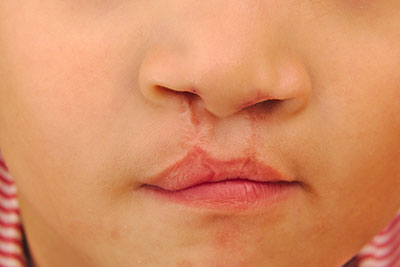Windpipe disorders are incredibly rare, but they are potentially life threatening and can have a marked impact on your child’s quality of life. Pediatric ENT of Oklahoma specializes in airway reconstruction for a variety of physical abnormalities and conditions. Delve into the five most common types and get to know the types of procedures we perform.
Cricotracheal Resection
Picture yourself sucking air through a straw. Now imagine pinching that straw and struggling to suck in more air. This is what happens when a child suffers from tracheal stenosis, a narrowing of the trachea (windpipe). Some children are born with it. Others develop it due to accidents or illnesses. Scar tissue from breathing tubes is one common cause.
If the area immediately below the larynx (voice box) develops stenosis, a specialized procedure is required. This is called a partial cricotracheal resection. The narrowed area of the trachea is removed. The back is left in-tact for structure, which is why it is considered partial. The two healthy halves of the trachea are then neatly sewn back together.
Endoscopic Laryngotracheal Cleft Repair

When you take a sip of water, a little strip of tissue is all that keeps you from inhaling it. After the water flows past your lips, it ends up in an area of your throat called the foregut. Your larynx and esophagus, the pathways for air and food, meet here. They are separated by a band of tissue called the tracheoesophageal septum.
For some children, the tracheoesophageal septum does not develop properly. A gap stays where food and liquids can pass through and be inhaled. Chronic cough, pneumonia and other concerns can quickly develop. This is called a laryngotracheal cleft (LCT). It is incredibly rare, and mild cases are often are not caught unless evaluated by a pediatric ENT.
For those mild cases, endoscopic laryngotracheal cleft repair can quickly and easily treat the issue. A clinical laser or microsurgical scissors are used to clean the edge of the cleft, and absorbable sutures are used to close it.
Laryngotracheal Reconstruction
Your child’s airway relies on partial rings of cartilage to stay stiff and upright. You can feel your own if gently feel the ridges in your neck. Children born without them or that lose them to illness or trauma are at risk for unstable airways. Full laryngotracheal reconstruction (LTR) give your child’s airway permanent stability and improved function.
There are several reasons LTR procedures are done, but the five most common are:
- Stenosis: In some children, the extent of the narrowing does not make them a candidate for tracheal resection. LTR is needed instead.
- Malformation of the larynx: When the larynx forms incorrectly or is damaged by illness, it may need to be repaired to function properly.
- Weak cartilage: This condition is called tracheomalacia. Some infants suffer from weak cartilage that cannot support their necks, making it difficult or impossible to breathe.
- Vocal cord paralysis: The vocal cords are made from folds of tissue that open and close over the airway, and paralysis is a threat to the airway. If they are stuck open, the airway and lungs have no protection. If they are stuck closed, breathing is impeded.
During LTR procedures, weak, damaged, scarred or otherwise ineffective parts of the airway are removed and replaced with cartilage grafts taken from other areas of the body. The grafts are often taken from the ear, ribs or thyroid. LTR surgery is done in single-stage and double-stage forms, without and with a tracheostomy tube respectively, depending on the situation and your pediatric ENT’s concerns.
Slide Tracheoplasty
For children with severe stenosis, at high risk for developing another stenosis in the future or with other health concerns, some corrective procedures are not advised. This is where slide tracheoplasty comes in.
In a slide tracheoplasty, the trachea is shortened and widened. Picture the top and bottom halves of the trachea as two circles. With careful incisions, the sides of the two circles are opened. The bottom is then slid up to meet the top, and the edges are sewn together to create one large oval.
Tracheal Resection
A full tracheal resection is performed when a child’s stenosis is not mild enough to not require slide tracheoplasty and or long enough to demand LTR. Unlike the partial resection discussed above, a full ring of tissue is removed in a normal tracheal resection.
Our Expert
Pediatric ENT Dr. Paul Digoy is a recognized specialist in both neonatal and pediatric airway reconstruction. Dr. Digoy is a Cornell graduate that completed his residency at UC San Diego Medical Center and a fellowship at Boston Children’s Hospital. He’s a Mercy Hospital affiliate and is proud to hold privileges there. If your child may need airway reconstruction, call today and schedule your consultation with Dr. Digoy.

